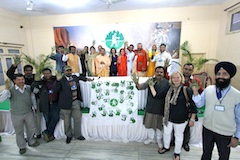| |
|
 |
Green Pilgrimage Network meeting in Rishikesh
December 27, 2012:
 |
 |
 |
Delegates show their green palms after symbolically 'signing' a specially designed banner (see below) with their handprints to signify their commitment to the Green Pilgrimage Network |
The Bhumi Project and ARC hosted a meeting of pilgrim towns, cities and sites as part of the Green Pilgrimage Network (India chapter) to discuss how to make pilgrimage places greener.
The meeting was co-hosted by the Ganga Action Parivar of Parmarth Niketan ashram in Rishikesh (www.gangaaction.com).
The meeting in Rishikesh on November 23 and 24 brought together representatives from the towns of Kolkata, Mayapur, Rishikesh, Sri Sailam, Varanasi, Vishakapatnam and Vrindavan. It also included key conservationists, including the head of Rajaji National Park and representatives of some of India’s most important tiger and wildlife reserves; a representative from ICLEI (www.iclei.org) to advise on sustainable city policy and faith leaders from different Hindu traditions.
The discussion circled around how to make pilgrimage places greener, and the theologies, technologies and possibilities of this.
Hindu Environment Day
Solutions included: inaugurating a Hindu Environment Day (with an annual week of action and reflection); education and outreach; establishing green standards for pilgrimage cities and their temples; working out the future and outreach of an Indian network of green pilgrimage cities.
The first morning opened with a welcome address by Pujya Swami Chidanand Saraswati of Parmarth Niketan. Speaking to the delegates, he expressed his pleasure at hosting them at his ashram and encouraging them to be the foundation of a new movement to preserving the sanctity of Hindu holy places. Pujya Swamiji is the inaugural chair for the Hindu members of the Green Pilgrimage Network.
Day one was dedicated to highlighting some of the successes, challenges and opportunities in pilgrim towns. Jayanta Basu spoke of the annual Durga Puja in Kolkata. Since 2007 he has worked with city authorities to minimise the environmental impact of the festival. He highlighted some of the steps taken, such as awareness raising and using lead-free paints on the deities which are submerged into the River Ganges as part of the festival.
Dr Rajendra Krishna shared the opportunities available for greening the Simhachalan temple in Vishakapatnam. He spoke of the possibility of improving the environmental standards of the temple and surrounding areas and things they are already doing, such as using bio-degradable plates.
Ganga aarti on the GangesThe day closed with a special havan on the banks of the Ganges and a Ganga aarti led by Pujya Swamiji.
The second day opened with an address by Sri Chaturvedi Swami, founder of the Sri Ramanuja Mission Trust. He spoke on the need for the development of good character if we are to make meaningful changes in the world. He also spoke of the Hindu view of the environment and its importance in the modern age.
This opening address then set the tone for the day as delegates broke into smaller groups to discuss short and long-term projects they could undertake in their religious towns and places. By the end of the discussions, some suggestions included:
- The introduction of an annual Hindu Environment Day (or Week) based around an appropriate existing Hindu festival or day.
- Developing a Green School Curriculum in every pilgrim city
- Developing realistic and action-based environmental standards for temples in pilgrim cities, towns and routes all around India, as well as for the towns and cities themselves, to allow comparison and improvement
- Pilgrimage shrines based near national wildlife parks to liaise with park authorities to cut down noise and light pollution and urgently find solutions for toilets and waste disposal. So many plastic bags are thrown around during pilgrimage (and at other times) that wild animals eat them and die in painful ways that are abhorrent to Hindu beliefs.
- Finding realistic, affordable solutions for solid waste management – i.e. cleaning up the many tonnes of trash that amass in India’s sacred places, particularly at key festivals, when millions of pilgrims can arrive at one time.
For the final session all delegates were asked to sign the international Green Pilgrimage Network vision statement. Each delegate then proceeded to place a green handprint on a specially-designed banner to mark their commitment.
|
 |
 |
|
|
|
|
|
 |
Green pilgrimage network members
The vision is of pilgrims on all continents and the pilgrim cities that receive them, leaving a positive footprint on the Earth |
 |
October 28, 2011:
100 million people go on pilgrimage every year
That is the astonishing figure calculated by ARC ahead of the launch ]of the world's first network aimed at greening pilgrimage. |
 |
October 15, 2012:
PRESS RELEASE: India Chapter of the Green Pilgrimage Network launched
Eleven holy towns and cities in India came together yesterday to launch the India chapter of the international Green Pilgrimage Network (GPN). The meeting, which took place on the seventh day of the United Nations COP 11 of the Convention on Biological Diversity, was hosted by ARC and ICLEI. |
 |
 |
|
|

